Knowledge Mapping of Cultural Ecosystem Services Applied on Blue-Green Infrastructure—A Scientometric Review with CiteSpace
Abstract
:1. Introduction
2. Materials and Methods
- (1)
- A literature review spanning from 2005 to September 2022 was conducted by employing CiteSpace’s literature co-citation analysis, cluster analysis, and keyword co-occurrence analysis. We were able to establish a comprehensive knowledge base and identify knowledge domains regarding the application of cultural ecosystem services in urban blue-green infrastructure as a result of this analysis.
- (2)
- By identifying citation surges, we identified patterns of knowledge evolution in CES applications within BGI.
- (3)
- A knowledge map was developed for the application of cultural ecosystem services in urban blue-green infrastructure, utilizing a knowledge base comprised of keywords pertinent to the research topic, domains of knowledge associated with fundamental research areas, and knowledge evolution as indicated by citation spurts. This knowledge map reflects the research hotspots and evolutionary process of the application of cultural ecosystem services in urban blue-green infrastructure studies.
2.1. Data Collection
2.2. Data Analysis
CiteSpace Software
3. Results
3.1. Trend of Papers Published
3.2. Research Cluster Analysis
3.3. Highly Cited Literature
3.4. Analysis of Research History
- (1)
- In general, clusters occurred most frequently between 2005 and 2015, coinciding with the most comprehensive research and considerable influence on CES inside BGI applications.
- (2)
- Some clusters that had previously wielded significant power are now receiving less attention and cooling off. Cluster 3 (urban green infrastructure), cluster 6 (cross-scale comparisons), cluster 8 (community gardens), cluster 10 (integration of ecosystem services), and cluster 16 (knowledge production) are notable examples.
- (3)
- In contrast, clusters begun later in the research timeline have maintained significant levels of interest and influence in recent years. Cluster 1 (nature-based solutions), cluster 2 (urban green space), cluster 4 (human physical and mental health), cluster 5 (social media), cluster 7 (relationship value), and cluster 11 (urban heat island) are among them.
- (4)
- In addition, Cluster 0 (ecosystem services) has received significant attention since its start.
3.5. Research Keywords
3.5.1. High-Frequency Keywords
3.5.2. Emerging Keywords
4. Discussion
4.1. Uneven Distribution of BGI Types
4.2. Unevenness of CES Categories in BGI
4.3. Research Directions for the Application of Cultural Ecosystem Services in Urban Blue-Green Infrastructure
4.4. Research Gaps and Outlook
- (1)
- Subsequent inquiries ought to broaden their scope by scrutinizing distinct varieties of BGI across numerous cities globally, encompassing even individual municipalities. This methodology promotes the investigation of diverse forms of BGI, with a particular emphasis on those that have been overlooked in previous studies or have research gaps that are directly applicable to individuals’ daily lives, such as green roofs or street greening [60]. Furthermore, we advocate for researchers to perceive BGI as a network that is interconnected and to examine the functioning of CES within this network.
- (2)
- In recent times, urban blue-green infrastructure research has diversified its focus from aesthetic and entertainment values to encompass educational and cultural heritage values as well [9]. This observed pattern indicates a growing emphasis on the inclusion of diverse services in cultural ecosystem services research. Further investigation into various forms of cultural ecosystem services should be the focus of future research to encompass all cultural ecosystem service values and, ultimately, to provide more robust support for practical applications.
- (3)
- It is critical to develop additional methods and techniques for evaluating cultural ecosystem services that are tailored to BGI contexts. By establishing unambiguous boundaries for the BGI and clarifying the interconnections among various cultural ecosystem service components, for instance, one can mitigate the risk of errors and uncertainties that may arise from redundant computations throughout the research endeavor [65].
- (4)
- Indicators of cultural ecosystem services ought to be formulated in a manner that is readily understandable to stakeholders, including policymakers and citizens. These indicators are of the utmost importance in promoting environmental protection awareness. An illustrative example is the notion of ‘landscape openness’ proposed by De Valck et al. [97], which functions as a metric for outdoor recreation and incorporates vegetation cover of varying degrees to symbolize distinct levels of openness. Indicators that are precisely defined and employ standardized classifications ought to garner greater interest and be the subject of additional discourse among researchers.
5. Conclusions
Funding
Conflicts of Interest
References
- Liu, H.Y.; Jay, M.; Chen, X. The Role of Nature-Based Solutions for Improving Environmental Quality, Health and Well-Being. Sustainability 2021, 13, 10950. [Google Scholar] [CrossRef]
- Garmendia, E.; Apostolopoulou, E.; Adams, W.M.; Bormpoudakis, D. Biodiversity and Green Infrastructure in Europe: Boundary object or ecological trap? Land Use Policy 2016, 56, 315–319. [Google Scholar] [CrossRef]
- Millennium Ecosystem Assessment. Ecosystems and Human Well-Being; Millennium Ecosystem Assessment: Washington, DC, USA, 2005. [Google Scholar]
- Plieninger, T.; Tianyu, G.U.O.; Haiyun, X.U. Development of cultural ecosystem services Contributes to a Plural Perspective for Human-Nature Studies—Interview with Tobias Plieninger. Landsc. Archit. Front. 2022, 10, 72–83. [Google Scholar] [CrossRef]
- Hajmirsadeghi, R.S. The influence of urban parks on sustainable city via increase quality of life. Sustain. Archit.-Elixir Int. J. 2012, 51, 10766–10770. [Google Scholar]
- Schnell, I.; Harel, N.; Mishori, D. The benefits of discrete visits in urban parks. Urban For. Urban Green. 2019, 41, 179–184. [Google Scholar] [CrossRef]
- Artmann, M.; Bastian, O.; Grunewald, K. Using the concepts of green infrastructure and ecosystem services to specify Leitbilder for compact and green cities—The example of the landscape plan of Dresden (Germany). Sustainability 2017, 9, 198. [Google Scholar] [CrossRef]
- Cheng, X.; Van Damme, S.; Uyttenhove, P. A review of empirical studies of cultural ecosystem services in urban green infrastructure. J. Environ. Manag. 2021, 293, 112895. [Google Scholar] [CrossRef] [PubMed]
- Cheng, X.; Van Damme, S.; Li, L.; Uyttenhove, P. Evaluation of cultural ecosystem services: A review of methods. Ecosyst. Serv. 2019, 37, 100925. [Google Scholar] [CrossRef]
- Guerrero, P.; Møller, M.S.; Olafsson, A.S.; Snizek, B. Revealing cultural ecosystem services through Instagram Images: The Potential of Social Media Volunteered Geographic Information for Urban Green Infrastructure Planning and Governance. Urban Plan. 2016, 1, 1–17. [Google Scholar] [CrossRef]
- Kati, V.; Jari, N. Bottom-up thinking—Identifying socio-cultural values of ecosystem services in local blue–green infrastructure planning in Helsinki, Finland. Land Use Policy 2016, 50, 537–547. [Google Scholar] [CrossRef]
- Zhang, S.; Muñoz Ramírez, F. Assessing and mapping ecosystem services to support urban green infrastructure: The case of Barcelona, Spain. Cities 2019, 92, 59–70. [Google Scholar] [CrossRef]
- Müller, F.; Bicking, S.; Ahrendt, K.; Bac, D.K.; Blindow, I.; Fürst, C.; Haase, P.; Kruse, M.; Kruse, T.; Ma, L.; et al. Assessing ecosystem service potentials to evaluate terrestrial, coastal and marine ecosystem types in Northern Germany—An expert-based matrix approach. Ecol. Indic. 2020, 112, 106116. [Google Scholar] [CrossRef]
- Amorim, J.H.; Engardt, M.; Johansson, C.; Ribeiro, I.; Sannebro, M. Regulating and cultural ecosystem services of Urban Green Infrastructure in the Nordic Countries: A Systematic Review. Int. J. Environ. Res. Public Health 2021, 18, 1219. [Google Scholar] [CrossRef] [PubMed]
- O’Brien, L.; De Vreese, R.; Kern, M.; Sievänen, T.; Stojanova, B.; Atmiş, E. Cultural ecosystem benefits of urban and peri-urban green infrastructure across different European countries. Urban For. Urban Green. 2017, 24, 236–248. [Google Scholar] [CrossRef]
- Hegetschweiler, K.T.; de Vries, S.; Arnberger, A.; Bell, S.; Brennan, M.; Siter, N.; Olafsson, A.S.; Voigt, A.; Hunziker, M. Linking demand and supply factors in identifying cultural ecosystem services of urban green infrastructures: A review of European studies. Urban For. Urban Green. 2017, 21, 48–59. [Google Scholar] [CrossRef]
- Klain, S.C.; Chan, K.M. Navigating coastal values: Participatory mapping of ecosystem services for spatial planning. Ecol. Econ. 2012, 82, 104–113. [Google Scholar] [CrossRef]
- Sherrouse, B.C.; Semmens, D.J.; Clement, J.M. An application of Social Values for Ecosystem Services (SolVES) to three national forests in Colorado and Wyoming. Ecol. Indic. 2014, 36, 68–79. [Google Scholar] [CrossRef]
- Haase, D.; Frantzeskaki, N.; Elmqvist, T. Ecosystem services in urban landscapes: Practical applications and governance implications. AMBIO 2014, 43, 407–412. [Google Scholar] [CrossRef]
- Gates, S. Review of methodology of quantitative reviews using meta-analysis in ecology. J. Anim. Ecol. 2022, 71, 547–557. [Google Scholar] [CrossRef]
- Feng, L.; Chiam, Y.K.; Lo, S.K. Text-mining techniques and tools for systematic literature reviews: A systematic literature review. In Proceedings of the 2017 24th Asia-Pacific Software Engineering Conference (APSEC), Nanjing, China, 4–8 December 2017; pp. 41–50. [Google Scholar]
- Yang, L.; Cao, K. Cultural ecosystem services research progress and future prospects: A review. Sustainability 2022, 14, 11845. [Google Scholar] [CrossRef]
- Liu, D.; Che, S.; Zhu, W. Visualizing the Knowledge Domain of Academic Mobility Research from 2010 to 2020: A Bibliometric Analysis Using CiteSpace. Sage Open 2022, 12, 21582440211068510. [Google Scholar] [CrossRef]
- Yang, R.; An, X.; Chen, Y.; Yang, X. The knowledge analysis of panel vector autoregression: A systematic review. SAGE Open 2023, 13, 21582440231215991. [Google Scholar] [CrossRef]
- Xu, H.; Plieninger, T.; Primdahl, J. A systematic comparison of cultural and ecological landscape corridors in Europe. Land 2019, 8, 41. [Google Scholar] [CrossRef]
- Shi, X.; Zhang, J.; Lu, J.; Zhao, T.; Yang, H.; Aria, A.; Qiu, Y.; Yu, L.; Ni, Y. Global Trends and Innovations in Forest Ecological Compensation: An Interdisciplinary Analysis. Forests 2024, 15, 631. [Google Scholar] [CrossRef]
- Donthu, N.; Kumar, S.; Mukherjee, D.; Pandey, N.; Lim, W.M. How to conduct a bibliometric analysis: An overview and guidelines. J. Bus. Res. 2021, 133, 285–296. [Google Scholar] [CrossRef]
- Zeleznik, D.; Vosner, H.B.; Kokol, P. A bibliometric analysis of the Journal of Advanced Nursing, 1976–2015. J. Adv. Nurs. 2017, 73, 2407–2419. [Google Scholar] [CrossRef] [PubMed]
- Wan, R.; Wan, R.; Qiu, Q. Progress and Prospects of Research on the Impact of Forest Therapy on Mental Health: A Bibliometric Analysis. Forests 2024, 15, 1013. [Google Scholar] [CrossRef]
- Chen, C. CiteSpace: A Practical Guide for Mapping Scientific Literature; Nova Science Publishers: Hauppauge, NY, USA, 2022; pp. 41–44. [Google Scholar]
- Bowler, D.E.; Buyung-Ali, L.; Knight, T.M.; Pullin, A.S. Urban greening to cool towns and cities: A systematic review of the empirical evidence. Landsc. Urban Plan. 2010, 97, 147–155. [Google Scholar] [CrossRef]
- Cameron, R.W.; Blanuša, T.; Taylor, J.E.; Salisbury, A.; Halstead, A.J.; Henricot, B.; Thompson, K. The domestic garden–Its contribution to urban green infrastructure. Urban For. Urban Green. 2012, 11, 129–137. [Google Scholar] [CrossRef]
- Chan, K.M.; Satterfield, T.; Goldstein, J. Rethinking ecosystem services to better address and navigate cultural values. Ecol. Econ. 2012, 74, 8–18. [Google Scholar] [CrossRef]
- Chiesura, A. The role of urban parks for the sustainable city. Landsc. Urban Plan. 2004, 68, 128–138. [Google Scholar] [CrossRef]
- Costanza, R.; De Groot, R.; Braat, L.; Kubiszewski, I.; Fioramonti, L.; Sutton, P.; Farber, S.; Grasso, M. Twenty years of ecosystem services: How far have we come and how far do we still need to go? Ecosyst. Serv. 2017, 28, 1–16. [Google Scholar] [CrossRef]
- Daniel, T.C.; Muhar, A.; Arnberger, A.; Aznar, O.; Boyd, J.W.; Chan, K.M.; Costanza, R.; Elmqvist, T.; Flint, C.G.; Gobster, P.H.; et al. Contributions of cultural services to the ecosystem services agenda. Proc. Natl. Acad. Sci. USA 2012, 109, 8812–8819. [Google Scholar] [CrossRef]
- Díaz, S.; Pascual, U.; Stenseke, M.; Martín-López, B.; Watson, R.T.; Molnár, Z.; Hill, R.; Chan, K.M.; Baste, I.A.; Brauman, K.A.; et al. Assessing nature’s contributions to people. Science 2018, 359, 270–272. [Google Scholar] [CrossRef]
- Foley, J.A.; DeFries, R.; Asner, G.P.; Barford, C.; Bonan, G.; Carpenter, S.R.; Chapin, F.S.; Coe, M.T.; Daily, G.C.; Gibbs, H.K.; et al. Global consequences of land use. Science 2005, 309, 570–574. [Google Scholar] [CrossRef] [PubMed]
- Gómez-Baggethun, E.; Reyes-García, V. Reinterpreting change in traditional ecological knowledge. Hum. Ecol. 2013, 41, 643–647. [Google Scholar] [CrossRef] [PubMed]
- Grahn, P.; Tenngart Ivarsson, C.; Stigsdotter, U.K.; Bengtsson, I.-L. Using affordances as a health-promoting tool in a therapeutic garden. Innov. Approaches Res. Landsc. Health 2010, 1, 116–154. [Google Scholar]
- Gunawardena, K.R.; Wells, M.J.; Kershaw, T. Utilising green and blue space to mitigate urban heat island intensity. Sci. Total Environ. 2017, 584, 1040–1055. [Google Scholar] [CrossRef]
- R Core Team. R: A Language and Environment for Statistical Computing; R Foundation for Statistical Computing: Vienna, Austria, 2020. [Google Scholar]
- Haaland, C.; van Den Bosch, C.K. Challenges and strategies for urban green-space planning in cities undergoing densification: A review. Urban For. Urban Green. 2015, 14, 760–771. [Google Scholar] [CrossRef]
- Haines-Young, R.; Potschin-Young, M.; Czúcz, B. Report on the Use of CICES to Identify and Characterise the Biophysical, Social and Monetary Dimensions of ES Assessments. Deliverable D4.2. 2018. Available online: https://maes-explorer.eu/files/ckeditor/wJflvEroiNcFwVFR8xSfqfUIOHYsI5JEnR69P9FW.pdf (accessed on 22 August 2024).
- Hartig, T.; Mitchell, R.; De Vries, S.; Frumkin, H. Nature and health. Annu. Rev. Public Health 2014, 35, 207–228. [Google Scholar] [CrossRef] [PubMed]
- James, P.; Tzoulas, K.; Adams, M.D.; Barber, A.; Box, J.; Breuste, J.; Elmqvist, T.; Frith, M.; Gordon, C.; Greening, K.L.; et al. Towards an integrated understanding of green space in the European built environment. Urban For. Urban Green. 2009, 8, 65–75. [Google Scholar] [CrossRef]
- Lee, A.C.; Maheswaran, R. The health benefits of urban green spaces: A review of the evidence. J. Public Health 2011, 33, 212–222. [Google Scholar] [CrossRef]
- Markevych, I.; Schoierer, J.; Hartig, T.; Chudnovsky, A.; Hystad, P.; Dzhambov, A.M.; De Vries, S.; Triguero-Mas, M.; Brauer, M.; Nieuwenhuijsen, M.J.; et al. Exploring pathways linking greenspace to health: Theoretical and methodological guidance. Environ. Res. 2017, 158, 301–317. [Google Scholar] [CrossRef]
- Meerow, S. The Contested Nature of Urban Resilience: Meaning and Models for Green Infrastructure and Climate Change Adaptation Planning. Doctoral Dissertation, University of Michigan, Ann Arbor, MI, USA, 2017. [Google Scholar]
- Morancho, A.B. A hedonic valuation of urban green areas. Landsc. Urban Plan. 2003, 66, 35–41. [Google Scholar] [CrossRef]
- Norton, B.A.; Coutts, A.M.; Livesley, S.J.; Harris, R.J.; Hunter, A.M.; Williams, N.S. Planning for cooler cities: A framework to prioritise green infrastructure to mitigate high temperatures in urban landscapes. Landsc. Urban Plan. 2015, 134, 127–138. [Google Scholar] [CrossRef]
- Sachs, J.D.; Schmidt-Traub, G.; Mazzucato, M.; Messner, D.; Nakicenovic, N.; Rockström, J. Six transformations to achieve the sustainable development goals. Nat. Sustain. 2019, 2, 805–814. [Google Scholar] [CrossRef]
- Wolch, J.R.; Byrne, J.; Newell, J.P. Urban green space, public health, and environmental justice: The challenge of making cities ‘just green enough’. Landsc. Urban Plan. 2014, 125, 234–244. [Google Scholar] [CrossRef]
- Plieninger, T.; Dijks, S.; Oteros-Rozas, E.; Bieling, C. Assessing, mapping, and quantifying cultural ecosystem services at community level. Land Use Policy 2013, 33, 118–129. [Google Scholar] [CrossRef]
- Martín-López, B.; Gómez-Baggethun, E.; Lomas, P.L.; Montes, C. Effects of spatial and temporal scales on cultural services valuation. J. Environ. Manag. 2009, 90, 1050–1059. [Google Scholar] [CrossRef]
- Tilliger, B.; Rodríguez-Labajos, B.; Bustamante, J.V.; Settele, J. Disentangling values in the interrelations between cultural ecosystem services and landscape conservation—A case study of the Ifugao Rice Terraces in the Philippines. Land 2015, 4, 888–913. [Google Scholar] [CrossRef]
- Braat, L.C.; Gómez-Baggethun, E.; Martín-López, B.; Barton, D.N.; García-Llorente, M.; Kelemen, E.; Saarikoski, H. Framework for Integration of Valuation Methods to Assess Ecosystem Service Policies; European Commission: Luxembourg, 2014; European Commission EU FP7 OpenNESS Project Deliverable, 4. [Google Scholar]
- Hirons, M.; Comberti, C.; Dunford, R. Valuing cultural ecosystem services. Annu. Rev. Environ. Resour. 2016, 41, 545–574. [Google Scholar] [CrossRef]
- Goldstein, J.H.; Caldarone, G.; Duarte, T.K.; Ennaanay, D.; Hannahs, N.; Mendoza, G.; Polasky, S.; Wolny, S.; Daily, G.C. Integrating ecosystem-service tradeoffs into land-use decisions. Proc. Natl. Acad. Sci. USA 2012, 109, 7565–7570. [Google Scholar] [CrossRef] [PubMed]
- Clark, D.A. Visions of Development: A Study of Human Values; Edward Elgar Publishing: Cheltenham, UK, 2002. [Google Scholar]
- Fisher, B.; Turner, K.; Zylstra, M.; Brouwer, R.; De Groot, R.; Farber, S.; Ferraro, P.; Green, R.; Hadley, D.; Harlow, J.; et al. Ecosystem services and economic theory: Integration for policy-relevant research. Ecol. Appl. 2008, 18, 2050–2067. [Google Scholar] [CrossRef] [PubMed]
- Bennett, J.W. The Ecological Transition: Cultural Anthropology and Human Adaptation; Routledge: Oxfordshire, UK, 2017. [Google Scholar]
- Tuck, E.; McKenzie, M. Place in Research: Theory, Methodology, and Methods; Routledge: Oxfordshire, UK, 2014. [Google Scholar]
- Satz, D.; Gould, R.K.; Chan, K.M.; Guerry, A.; Norton, B.; Satterfield, T.; Halpern, B.S.; Levine, J.; Woodside, U.; Hannahs, N.; et al. The challenges of incorporating cultural ecosystem services into environmental assessment. AMBIO 2013, 42, 675–684. [Google Scholar] [CrossRef] [PubMed]
- Jiang, L.; Liu, S.; Liu, C. The Contributions of blue-green infrastructure to Building Urban Climatic Resilience—Bibliometric Analysis Based on Co-citation Networks. Landsc. Archit. Front. 2021, 9, 8. [Google Scholar] [CrossRef]
- Hillsdon, M.; Foster, C.; Thorogood, M. Interventions for promoting physical activity. Cochrane Database Syst. Rev. 2005, 1, CD003180. [Google Scholar]
- Daley, A.J. School based physical activity in the United Kingdom: Can it create physically active adults? Quest 2002, 54, 21–33. [Google Scholar] [CrossRef]
- Sandifer, P.A.; Sutton-Grier, A.E.; Ward, B.P. Exploring connections among nature, biodiversity, ecosystem services, and human health and well-being: Opportunities to enhance health and biodiversity conservation. Ecosyst. Serv. 2015, 12, 1–15. [Google Scholar] [CrossRef]
- Banela, M.; Kyvelou, S.S.; Kitsiou, D. Mapping and Assessing cultural ecosystem services to Inform Maritime Spatial Planning: A Systematic Review. Heritage 2024, 7, 697–736. [Google Scholar] [CrossRef]
- Hou, P.; Wang, Q.; Shen, W.M.; Zhai, J.; Liu, H.M.; Yang, M. Progress of integrated ecosystem assessment: Concept, framework and challenges. Geogr. Res. 2015, 34, 1809–1823. [Google Scholar]
- Pascual, U.; Balvanera, P.; Díaz, S.; Pataki, G.; Roth, E.; Stenseke, M.; Watson, R.T.; Dessane, E.B.; Islar, M.; Kelemen, E.; et al. Valuing nature’s contributions to people: The IPBES approach. Curr. Opin. Environ. Sustain. 2017, 26, 7–16. [Google Scholar] [CrossRef]
- Quintas-Soriano, C.; Brandt, J.S.; Running, K.; Baxter, C.V.; Gibson, D.M.; Narducci, J.; Castro, A.J. Social-ecological systems influence ecosystem service perception: A Programme on Ecosystem Change and Society (PECS) analysis. Ecol. Soc. 2018, 23, 18. [Google Scholar] [CrossRef]
- Brown, G.; Fagerholm, N. Empirical PPGIS/PGIS mapping of ecosystem services: A review and evaluation. Ecosyst. Serv. 2015, 13, 119–133. [Google Scholar] [CrossRef]
- Zhai, Y.; Li, D.; Wu, C.; Wu, H. Spatial distribution, activity zone preference, and activity intensity of senior park users in a metropolitan area. Urban For. Urban Green. 2023, 79, 127761. [Google Scholar] [CrossRef]
- Jiang, Q.; Wang, G.; Liang, X.; Liu, N. Research on the Perception of cultural ecosystem services in Urban Parks via Analyses of Online Comment Data. Landsc. Archit. Front. 2022, 10, 32. [Google Scholar]
- Depietri, Y.; Ghermandi, A.; Campisi-Pinto, S.; Orenstein, D.E. Public participation GIS versus geolocated social media data to assess urban cultural ecosystem services: Instances of complementarity. Ecosyst. Serv. 2021, 50, 101277. [Google Scholar] [CrossRef]
- Xu, H.; Zhao, G.; Liu, Y.; Miao, M. Using Social Media Camping Data for Evaluating, Quantifying, and Understanding Recreational Ecosystem Services in Post-COVID-19 Megacities: A Case Study from Beijing. Forests 2023, 14, 1151. [Google Scholar] [CrossRef]
- Zhao, X. Environmental perception of farmers of different livelihood strategies: A case of Gannan Plateau. Acta Ecol. Sin. 2012, 32, 6776–6787. [Google Scholar] [CrossRef]
- Nawrath, M.; Elsey, H.; Dallimer, M. Why cultural ecosystem services matter most: Exploring the pathways linking greenspaces and mental health in a low-income country. Sci. Total Environ. 2022, 806, 150551. [Google Scholar] [CrossRef]
- Wang, J.; Wu, W.; Yang, M.; Gao, Y.; Shao, J.; Yang, W.; Ma, G.; Yu, F.; Yao, N.; Jiang, H. Exploring the complex trade-offs and synergies of global ecosystem services. Environ. Sci. Ecotechnol. 2024, 21, 100391. [Google Scholar] [CrossRef] [PubMed]
- Dou, Y.; Zhen, L.; De Groot, R.; Du, B.; Yu, X. Assessing the importance of cultural ecosystem services in urban areas of Beijing municipality. Ecosyst. Serv. 2017, 24, 79–90. [Google Scholar] [CrossRef]
- Xu, H.; Zhao, G.; Fagerholm, N.; Primdahl, J.; Plieninger, T. Participatory mapping of cultural ecosystem services for landscape corridor planning: A case study of the Silk Roads corridor in Zhangye, China. J. Environ. Manag. 2020, 264, 110458. [Google Scholar] [CrossRef]
- Taye, F.A.; Folkersen, M.V.; Fleming, C.M.; Buckwell, A.; Mackey, B.; Diwakar, K.C.; Le, D.; Hasan, S.; Saint Ange, C. The economic values of global forest ecosystem services: A meta-analysis. Ecol. Econ. 2021, 189, 107145. [Google Scholar] [CrossRef]
- Martin, C.L.; Momtaz, S.; Gaston, T.; Moltschaniwskyj, N.A. A systematic quantitative review of coastal and marine cultural ecosystem services: Current status and future research. Mar. Policy 2016, 74, 25–32. [Google Scholar] [CrossRef]
- Meerow, S.; Newell, J.P. Spatial planning for multifunctional green infrastructure: Growing resilience in Detroit. Landsc. Urban Plan. 2017, 159, 62–75. [Google Scholar] [CrossRef]
- Chan, K.M.; Balvanera, P.; Benessaiah, K.; Chapman, M.; Díaz, S.; Gómez-Baggethun, E.; Gould, R.; Hannahs, N.; Jax, K.; Klain, S.; et al. Why protect nature? Rethinking values and the environment. Proc. Natl. Acad. Sci. USA 2016, 113, 1462–1465. [Google Scholar] [CrossRef] [PubMed]
- Fish, R.; Church, A.; Winter, M. Conceptualising cultural ecosystem services: A novel framework for research and critical engagement. Ecosyst. Serv. 2016, 21, 208–217. [Google Scholar] [CrossRef]
- Kleinberg, J. Bursty and hierarchical structure in streams. In Proceedings of the Eighth ACM SIGKDD International Conference on Knowledge Discovery and Data Mining 2022, Washington, DC, USA, 14–18 August 2022; pp. 91–101. [Google Scholar]
- Milcu, A.I.; Hanspach, J.; Abson, D.; Fischer, J. cultural ecosystem services: A literature review and prospects for future research. Ecol. Soc. 2013, 18, 34. [Google Scholar] [CrossRef]
- Tauro, A.; Gómez-Baggethun, E.; García-Frapolli, E.; Chavero, E.L.; Balvanera, P. Unraveling heterogeneity in the importance of ecosystem services. Ecol. Soc. 2018, 23, 37. [Google Scholar] [CrossRef]
- Wendel HE, W.; Zarger, R.K.; Mihelcic, J.R. Accessibility and usability: Green space preferences, perceptions, and barriers in a rapidly urbanizing city in Latin America. Landsc. Urban Plan. 2012, 107, 272–282. [Google Scholar] [CrossRef]
- La Notte, A.; D’Amato, D.; Mäkinen, H.; Paracchini, M.L.; Liquete, C.; Egoh, B.; Geneletti, D.; Crossman, N.D. Ecosystem services classification: A systems ecology perspective of the cascade framework. Ecol. Indic. 2017, 74, 392–402. [Google Scholar] [CrossRef]
- Potschin, M.; Haines-Young, R. Landscapes, sustainability and the place-based analysis of ecosystem services. Landsc. Ecol. 2013, 28, 1053–1065. [Google Scholar] [CrossRef]
- Ko, H.; Son, Y. Perceptions of cultural ecosystem services in urban green spaces: A case study in Gwacheon, Republic of Korea. Ecol. Indic. 2018, 91, 299–306. [Google Scholar] [CrossRef]
- Costanza, R.; de Groot, R.; Sutton, P.; van der Ploeg, S.; Anderson, S.J.; Kubiszewski, I.; Farber, S.; Turner, R.K. Changes in the global value of ecosystem services. Glob. Environ. Change 2014, 26, 152–158. [Google Scholar] [CrossRef]
- Fu, B.J.; Su, C.H.; Wei, Y.P.; Willett, I.R.; Lü, Y.H.; Liu, G.H. Double counting in ecosystem services valuation: Causes and countermeasures. Ecol. Res. 2011, 26, 1–14. [Google Scholar] [CrossRef]
- De Valck, J.; Landuyt, D.; Broekx, S.; Liekens, I.; De Nocker, L.; Vranken, L. Outdoor recreation in various landscapes: Which site characteristics really matter? Land Use Policy 2017, 65, 186–197. [Google Scholar] [CrossRef]
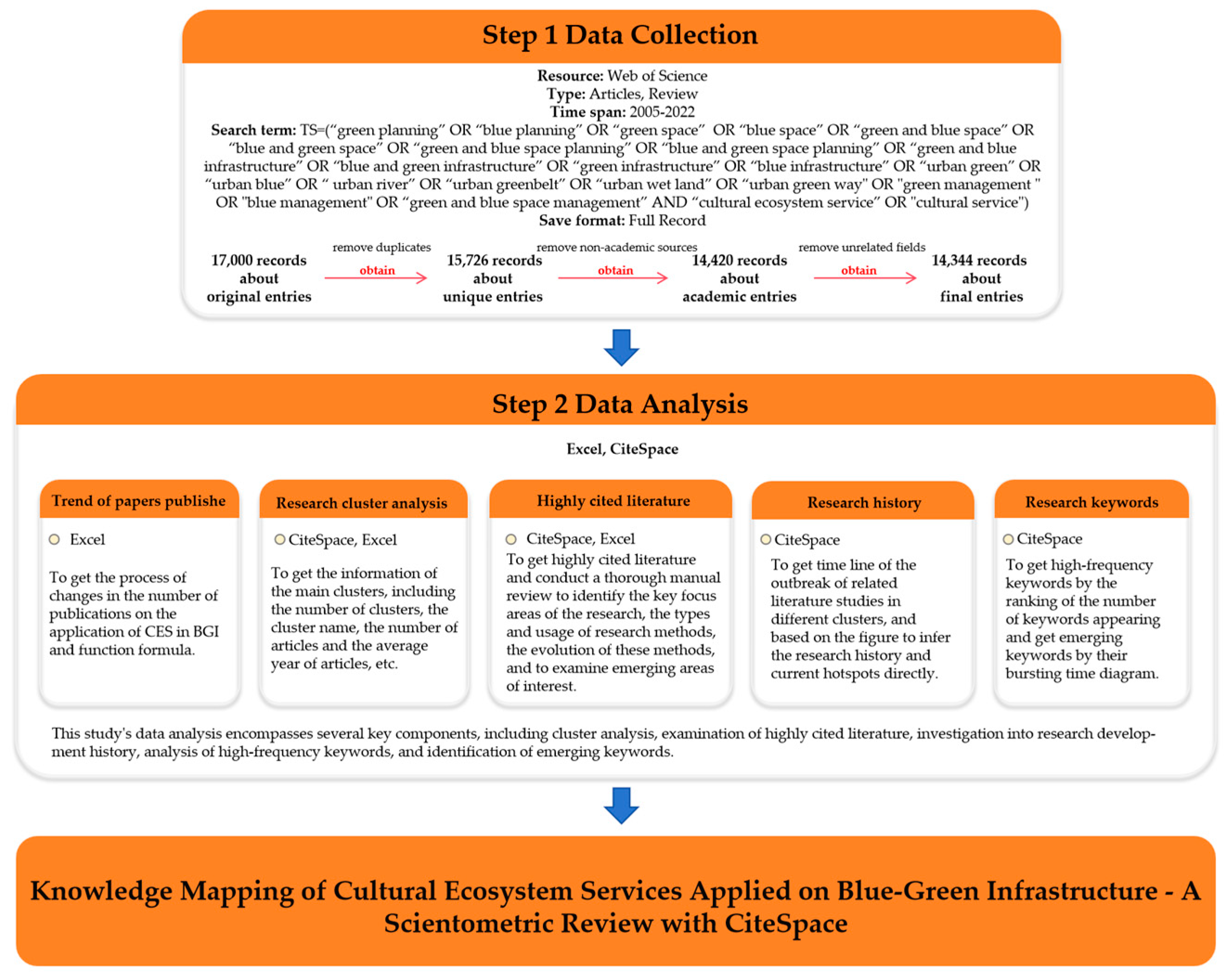
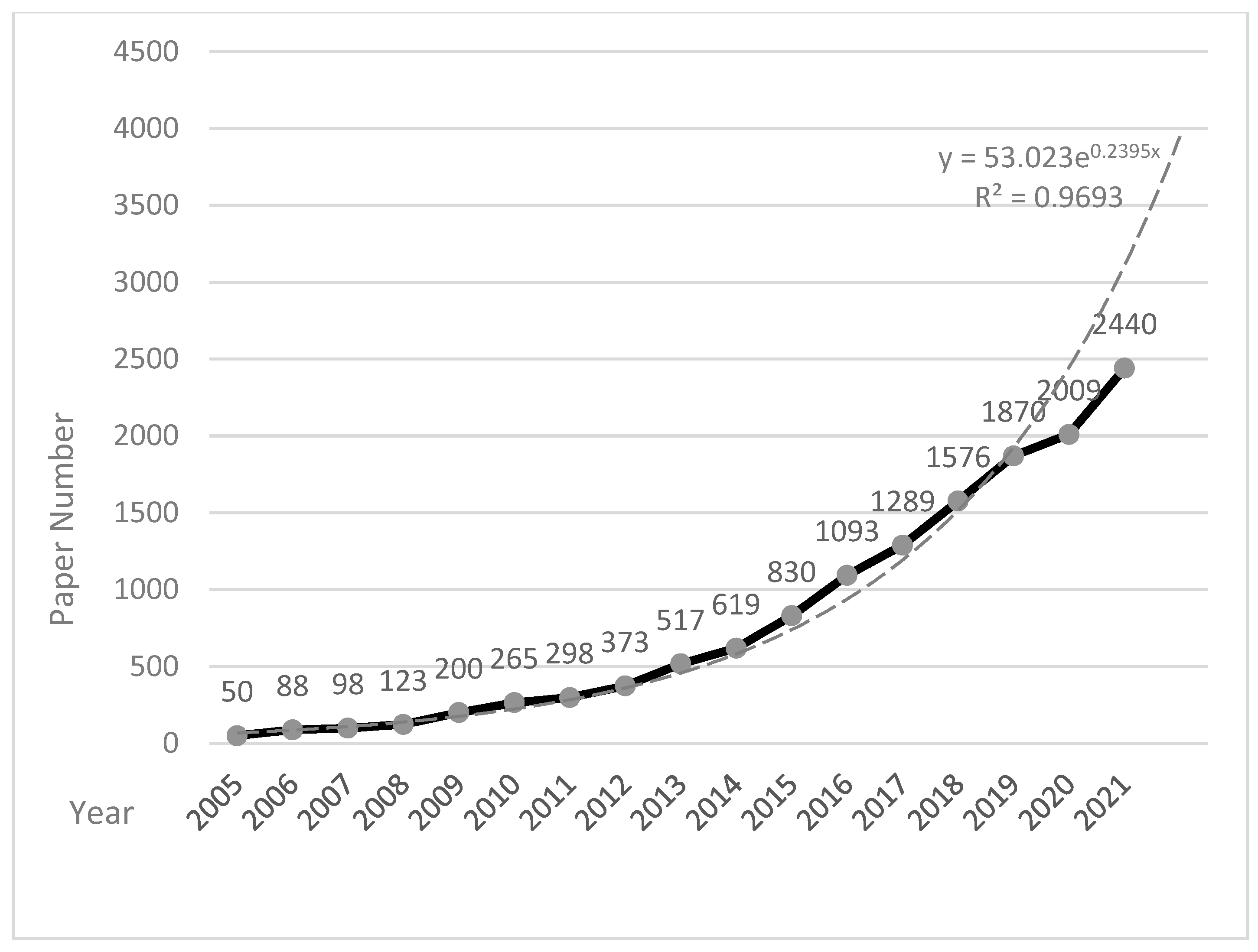
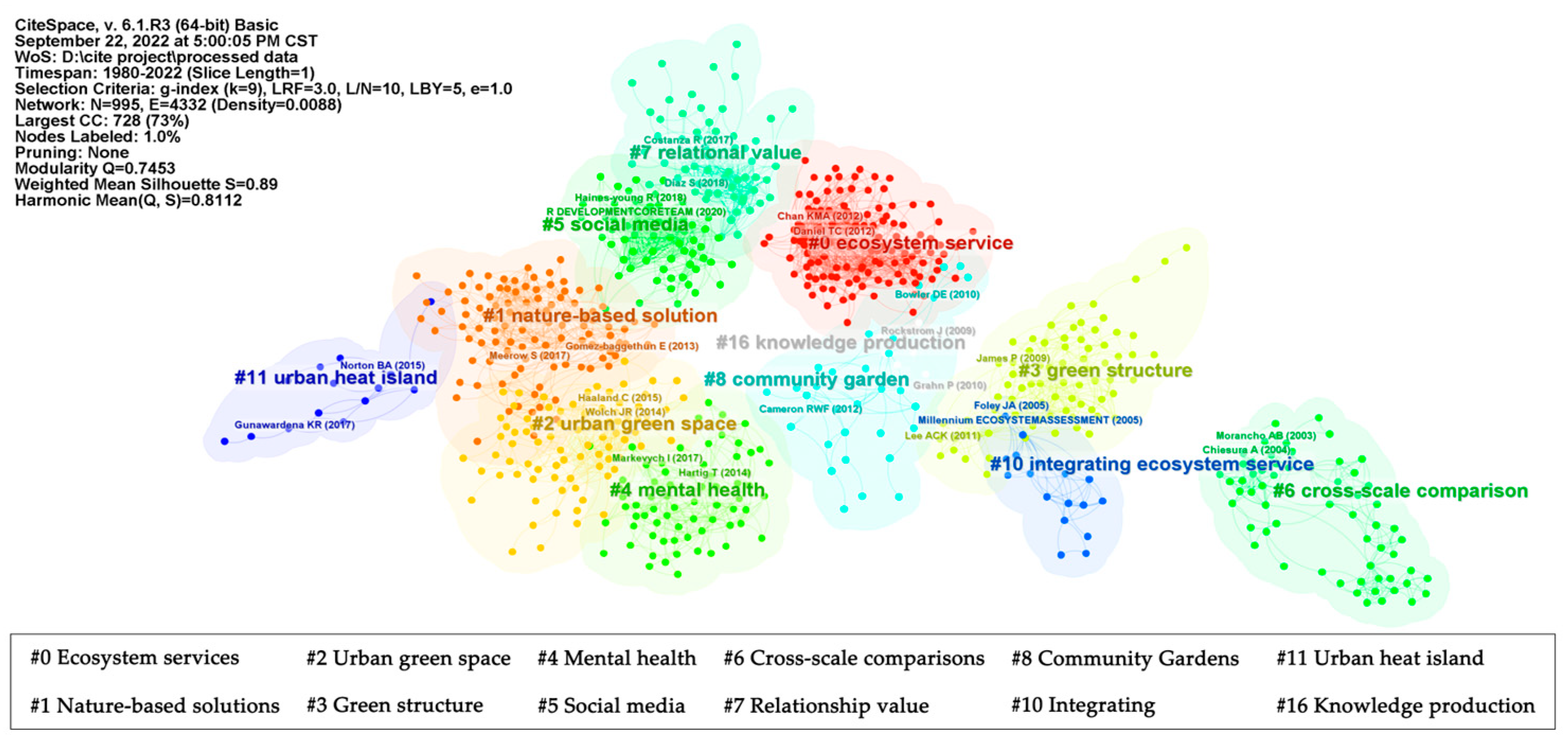
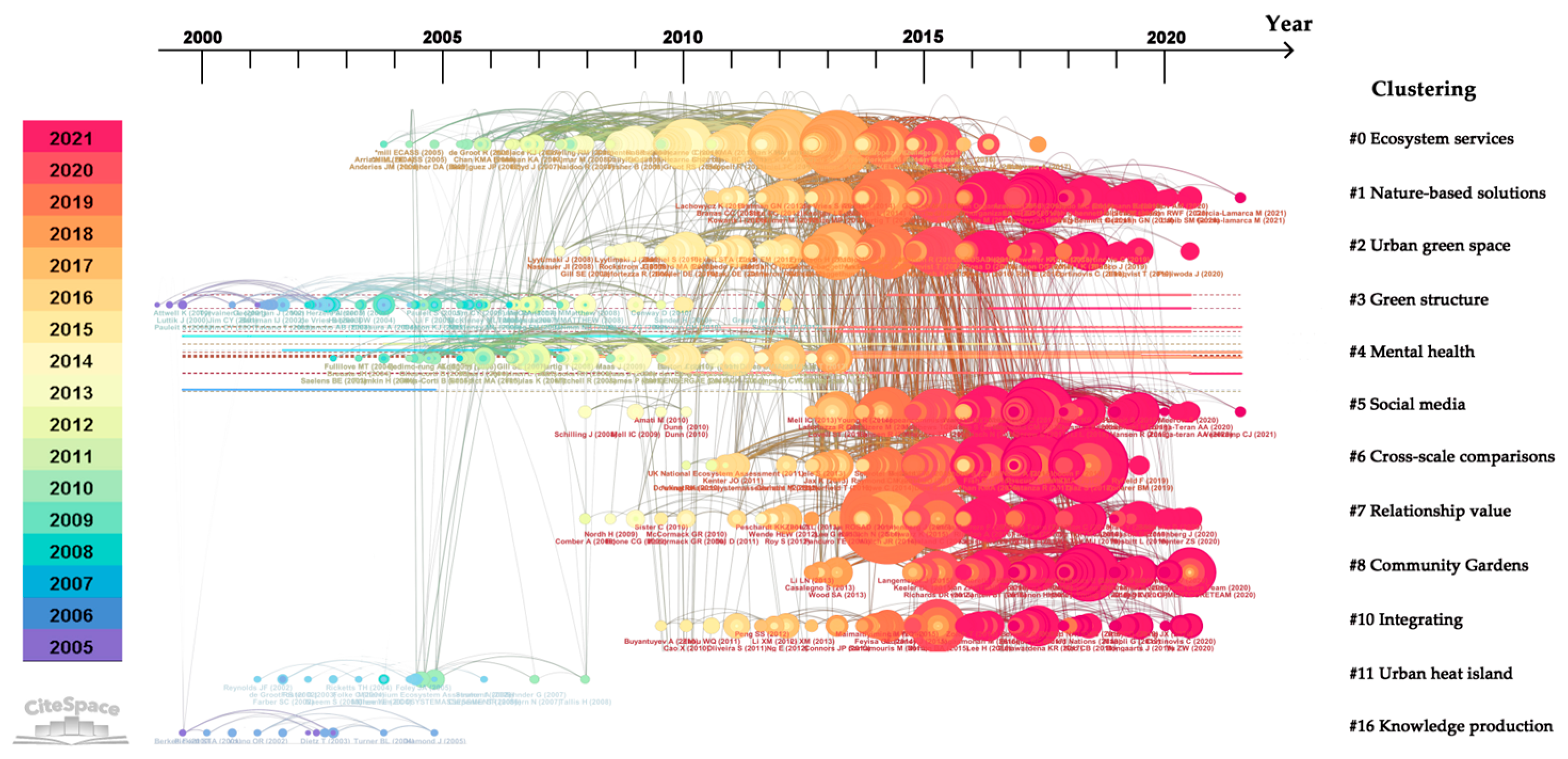
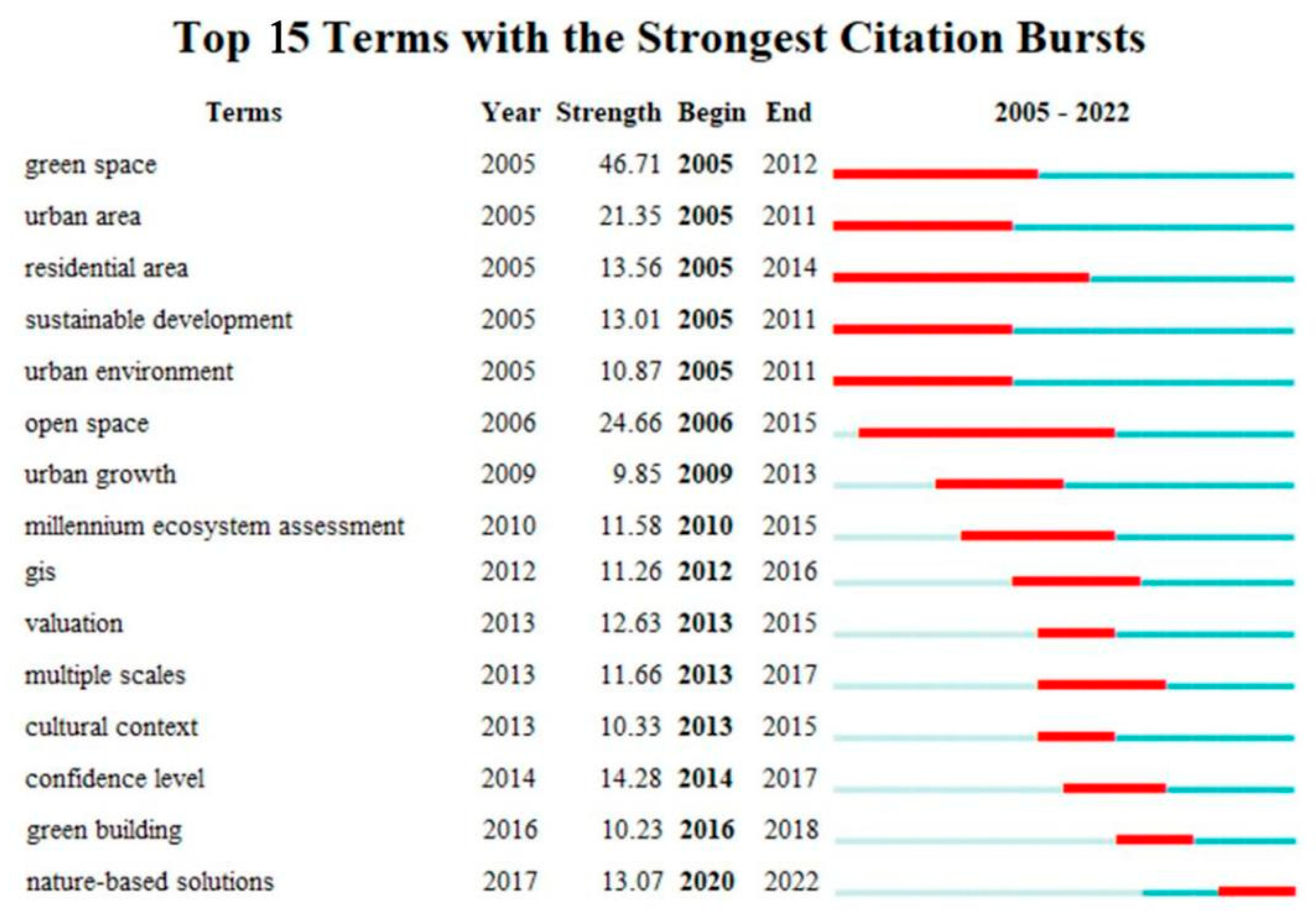
| Serial Number | Cluster Name | Magnitude | Homogeneity | Average Year |
|---|---|---|---|---|
| 0 | Ecosystem services | 130 | 0.84 | 2010 |
| 1 | Nature-based solutions | 106 | 0.889 | 2016 |
| 2 | Urban green space | 84 | 0.806 | 2015 |
| 3 | Green structure | 80 | 0.907 | 2007 |
| 4 | Mental health | 69 | 0.943 | 2015 |
| 5 | Social media | 67 | 0.887 | 2016 |
| 6 | Cross-scale comparisons | 62 | 0.962 | 2002 |
| 7 | Relationship value | 59 | 0.872 | 2015 |
| 8 | Community gardens | 31 | 0.945 | 2010 |
| 10 | Integrating | 17 | 0.978 | 2003 |
| 11 | Urban heat island | 14 | 0.988 | 2015 |
| 16 | Knowledge production | 9 | 0.943 | 2011 |
| Serial Number | Clustering | Author | Article Area | Journals | Title | Number of Citations |
|---|---|---|---|---|---|---|
| 1 | 2 | Wolch, J.R. | USA | Landscape and Urban Planning | Urban green space, public health, and environmental justice: The challenge of making cities ‘just green enough [53] | 312 |
| 2 | 7 | Díaz, S. | USA | AAAS | Assessing nature’s contributions to people [37] | 222 |
| 3 | 0 | Daniel, T.C. | USA | PNAS | Contributions of cultural services to the ecosystem services agenda [36] | 203 |
| 4 | 7 | Costanza, R. | Australia | Ecosystem Services | Twenty years of ecosystem services: How far have we come and how far do we still need to go? [35] | 194 |
| 5 | 0 | Chan, K.M. | USA | Ecological Economics | Rethinking ecosystem services to better address and navigate cultural values [33] | 186 |
| 6 | 1 | Meerow, S. | USA | Landscape and Urban Planning | Spatial planning for multifunctional green infrastructure: growing resilience in Detroit [85] | 186 |
| 7 | 0 | Plieninger T. | Germany | Land Use Policy | Assessing, mapping, and quantifying cultural ecosystem services at community level [54] | 184 |
| 8 | 7 | Chan, K.M. | USA | PNAS | Why protect nature? Rethinking values and the environment [86] | 171 |
| 9 | 7 | Pascual, U. | Spain | Environment Sustainability | Valuing nature’s contributions to people: the IPBes approach [71] | 166 |
| 10 | 7 | Fish, R. | United Kingdom | Ecosystem Services | Conceptualising cultural ecosystem services: A novel framework for research and critical engagement [87] | 163 |
Disclaimer/Publisher’s Note: The statements, opinions and data contained in all publications are solely those of the individual author(s) and contributor(s) and not of MDPI and/or the editor(s). MDPI and/or the editor(s) disclaim responsibility for any injury to people or property resulting from any ideas, methods, instructions or products referred to in the content. |
© 2024 by the authors. Licensee MDPI, Basel, Switzerland. This article is an open access article distributed under the terms and conditions of the Creative Commons Attribution (CC BY) license (https://creativecommons.org/licenses/by/4.0/).
Share and Cite
Li, J.; Xu, H.; Ren, M.; Duan, J.; You, W.; Zhou, Y. Knowledge Mapping of Cultural Ecosystem Services Applied on Blue-Green Infrastructure—A Scientometric Review with CiteSpace. Forests 2024, 15, 1736. https://doi.org/10.3390/f15101736
Li J, Xu H, Ren M, Duan J, You W, Zhou Y. Knowledge Mapping of Cultural Ecosystem Services Applied on Blue-Green Infrastructure—A Scientometric Review with CiteSpace. Forests. 2024; 15(10):1736. https://doi.org/10.3390/f15101736
Chicago/Turabian StyleLi, Jinfeng, Haiyun Xu, Mujie Ren, Jiaxuan Duan, Weiwen You, and Yuan Zhou. 2024. "Knowledge Mapping of Cultural Ecosystem Services Applied on Blue-Green Infrastructure—A Scientometric Review with CiteSpace" Forests 15, no. 10: 1736. https://doi.org/10.3390/f15101736





